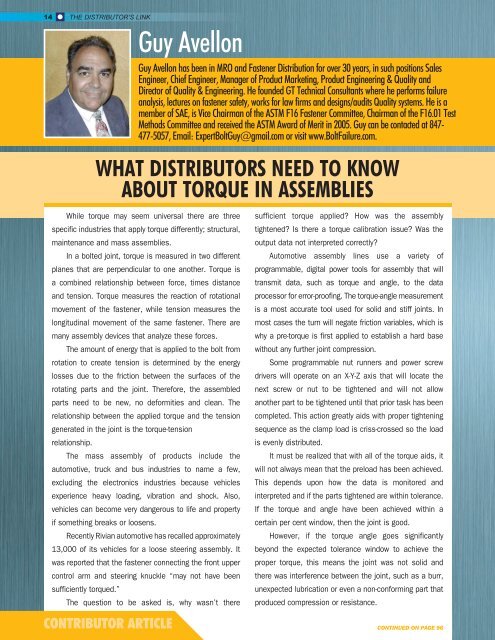SUMMER 2023
Distributor's Link Magazine Summer 2023 / Vol 46 No 3
Distributor's Link Magazine Summer 2023 / Vol 46 No 3
You also want an ePaper? Increase the reach of your titles
YUMPU automatically turns print PDFs into web optimized ePapers that Google loves.
14<br />
THE DISTRIBUTOR’S LINK<br />
Guy Avellon<br />
Guy Avellon has been in MRO and Fastener Distribution for over 30 years, in such positions Sales<br />
Engineer, Chief Engineer, Manager of Product Marketing, Product Engineering & Quality and<br />
Director of Quality & Engineering. He founded GT Technical Consultants where he performs failure<br />
analysis, lectures on fastener safety, works for law firms and designs/audits Quality systems. He is a<br />
member of SAE, is Vice Chairman of the ASTM F16 Fastener Committee, Chairman of the F16.01 Test<br />
Methods Committee and received the ASTM Award of Merit in 2005. Guy can be contacted at 847-<br />
477-5057, Email: ExpertBoltGuy@gmail.com or visit www.BoltFailure.com.<br />
WHAT DISTRIBUTORS NEED TO KNOW<br />
ABOUT TORQUE IN ASSEMBLIES<br />
While torque may seem universal there are three<br />
specific industries that apply torque differently; structural,<br />
maintenance and mass assemblies.<br />
In a bolted joint, torque is measured in two different<br />
planes that are perpendicular to one another. Torque is<br />
a combined relationship between force, times distance<br />
and tension. Torque measures the reaction of rotational<br />
movement of the fastener, while tension measures the<br />
longitudinal movement of the same fastener. There are<br />
many assembly devices that analyze these forces.<br />
The amount of energy that is applied to the bolt from<br />
rotation to create tension is determined by the energy<br />
losses due to the friction between the surfaces of the<br />
rotating parts and the joint. Therefore, the assembled<br />
parts need to be new, no deformities and clean. The<br />
relationship between the applied torque and the tension<br />
generated in the joint is the torque-tension<br />
relationship.<br />
The mass assembly of products include the<br />
automotive, truck and bus industries to name a few,<br />
excluding the electronics industries because vehicles<br />
experience heavy loading, vibration and shock. Also,<br />
vehicles can become very dangerous to life and property<br />
if something breaks or loosens.<br />
Recently Rivian automotive has recalled approximately<br />
13,000 of its vehicles for a loose steering assembly. It<br />
was reported that the fastener connecting the front upper<br />
control arm and steering knuckle “may not have been<br />
sufficiently torqued.”<br />
The question to be asked is, why wasn’t there<br />
CONTRIBUTOR ARTICLE<br />
sufficient torque applied? How was the assembly<br />
tightened? Is there a torque calibration issue? Was the<br />
output data not interpreted correctly?<br />
Automotive assembly lines use a variety of<br />
programmable, digital power tools for assembly that will<br />
transmit data, such as torque and angle, to the data<br />
processor for error-proofing. The torque-angle measurement<br />
is a most accurate tool used for solid and stiff joints. In<br />
most cases the turn will negate friction variables, which is<br />
why a pre-torque is first applied to establish a hard base<br />
without any further joint compression.<br />
Some programmable nut runners and power screw<br />
drivers will operate on an X-Y-Z axis that will locate the<br />
next screw or nut to be tightened and will not allow<br />
another part to be tightened until that prior task has been<br />
completed. This action greatly aids with proper tightening<br />
sequence as the clamp load is criss-crossed so the load<br />
is evenly distributed.<br />
It must be realized that with all of the torque aids, it<br />
will not always mean that the preload has been achieved.<br />
This depends upon how the data is monitored and<br />
interpreted and if the parts tightened are within tolerance.<br />
If the torque and angle have been achieved within a<br />
certain per cent window, then the joint is good.<br />
However, if the torque angle goes significantly<br />
beyond the expected tolerance window to achieve the<br />
proper torque, this means the joint was not solid and<br />
there was interference between the joint, such as a burr,<br />
unexpected lubrication or even a non-conforming part that<br />
produced compression or resistance.<br />
CONTINUED ON PAGE 96
















